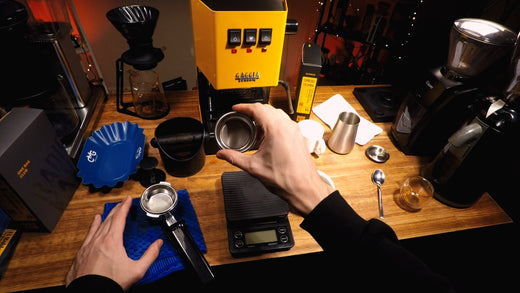
How to choose coffee beans for Turkish coffee
Share
Turkish coffee is quite a special brewing method. Because it allows you to use any coffee beans and have a proper taste if brewed correctly.
But because we all have different taste preferences, here's the best way to navigate through different coffees. Because modern coffee has become very complex and diverse.
The things we will look at
- Roast level (dark, medium, light)
- Processing method (Natural, Washed)
- Flavor notes and region
Search of the best flavor is a journey. And I suggest you try everything.
Dark Roast
Such coffee will be rich and “oily”. Quite intense. But it lacks flavor diversity. Mostly it will be “roasty”, rubber, tobacco, nuts and bad chocolate flavors. Though if you’re into such notes - fine.
And it’s suitable for drinking it with sweets like lucum.
Such coffee should be brewed towards a “full wrap” of the foam and beyond that point.
Side notes
When we roasting coffee it loses complexity of the flavor. Or just shifting them towards other flavors, depends how you look at it. Chemical compounds which create the flavor are degrading to the point where we have a “coffee flavor”. But what we used to perceive as “coffee flavor” - shouldn’t be the dominating thing in your cup. At least, when coffee is interesting. And the main reason why such coffee is roasted dark - because it has a low quality and will not be tasty if roasted lighter (most of the time, there are exceptions).
Medium roast
What I want people to try is interesting coffee flavors. And they mostly start to be perceived from here. Medium or espresso roast. And such coffee is usually called “specialty”.
First step is to get a bag of Natural Processed coffee. Since it is usually perceived as “less acidic”. And have a richer flavor and mouthfeel which people expect from coffee. It’s probably the best choice for most people.
Then try Washed processed. It will have a somewhat thinner flavor and more clarity.
I recommend drinking it when it cooled down for around 5 minutes after serving into the cup right after brewing. That way you will perceive more flavors.
Most of the time I recommend brewing it to the full wrap of the foam to get the best result. And if it starts to be “too bitter” which can cover the flavors - wrap the foam less.
You can read about control of the foam wrapping here.
Light roast
It is not for everybody, but it will be the most complex in terms of flavors. And most interesting. Imagine trying coffee which tastes like peach or apricot. It’s a very nice experience.
Again, start with natural processed. Because this coffee will be even more “thinner” and less oily. And natural processed coffee gives you a mouthfeel which “supports” the flavors.
But then - try washed processed. It’ll be the cleanest flavor that you can get.
Both coffees are better to be consumed with the lower temperature. Because of the lower body (mouthfeel) it could be “tasteless” when hot or “unbalanced”. When it cools down (around 10 minutes after serving into the cup) it opens up and you will perceive everything.
Overall it could be like a very interesting juice or nectar. With a tea-like body and lightness.
As for the brewing - it’s usually in the middle of the wrap of the foam when you need to take it off the heat and serve. If you want more mouthfeel - brew it longer (full wrap).
Roast level wrapping up
It’s more about mouthfeel and the flavors that you want to perceive. If your goal is to perceive as many flavors as coffee can provide - go with the light roast. If you want a boring and stable flavor - go with dark roast. I personally hop between different light roast coffee.
Sometimes I’m in the mood for something medium roast, especially in cold seasons, when mouthfeel is more important and pleasant. And these “heavy” notes aren’t bothering. Or when I want coffee with some sweets, I will not waste light roast for that.
Flavors, regions
Yes, at first we look at the roast level since it’s the most dominant thing when it comes to flavor. But then we pay attention to the flavors that are mentioned on the coffee bag. Especially when we go closer to the lighter roast.
Flavors that usually aren’t acidic: apple, citrus. It will be delicate, with mild acidity. Especially if there are flavors like nuts, chocolate.
But if you see berries - it’s a sign that it will be acidic. But still, it should be a nice acidity, not higher than biting an apple. At least when brewed properly.
As for the regions, if you’re not into acidic coffee, stay away from origins like Rwanda, Kenya, Burundi, Guatemala. Since they are usually quite acidic.
Neutral region is Brazil. Most of the time - Indonesia.
More interesting flavor while keeping relatively low acidity: Honduras, El Salvador, Ethiopia, Peru.
Colombia is tricky, but usually mostly acidic. Could be extremely diverse though.
But Ethiopian coffee, especially natural processed, will be the best choice for most people.
Wrapping up
That’s probably it. But I have selected coffee and made sets so you can get exactly what you expect.
Set #1 - “everyday” coffee. Not dark, but with lower acidity due to longer roasting. Pretty rich in flavor and some diversity is present.
Set #2 - specialty coffee with diverse flavors. Sweet and Acidic selections are available as well as roast level (light, medium).






